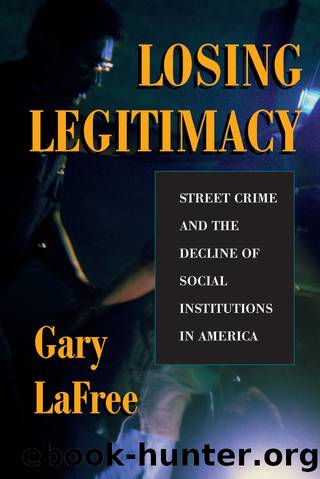Losing Legitimacy by Gary Lafree

Author:Gary Lafree [Lafree, Gary]
Language: eng
Format: epub
Tags: Social Science, General, Sociology
ISBN: 9780429978760
Google: iTlMDwAAQBAJ
Barnesnoble:
Publisher: Routledge
Published: 2018-02-02T00:00:00+00:00
The Middle Postwar Period, 1961â1973
If economic trends in the early postwar years seem to fit crime trends nearly perfectly, economic trends in the middle postwar years posed a challenge for American criminologists that ended up fundamentally reshaping both research and policy on crime for decades to come. The central problem is well expressed in James Q. Wilson's 1975 challenge to criminologists to explain "the paradox" of "crime amidst plenty."40 Indeed, in many respects the economic picture of the United States in the middle postwar period was even more favorable than it had been in the early postwar years. Productivity declined slightly in the 1960s but remained at historically high levels. A typical working male in his late twenties in 1959 would see his real income grow by 49 percent over the decade of the sixties.41 These trends are illustrated in Figure 7.1, which shows median income for American men in inflation-adjusted dollars from 1947 to 1995. To allow easy comparison, I include robbery rates for the same period.
Figure 7.1 clearly demonstrates the vulnerability of common strain theory explanations based on the connections between economic stress and crime in the middle postwar period. As shown in Figure 7.1, inflation-adjusted income for American males grew steadily from 1960 to 1973âabout the same time as the postwar crime boom. In fact, it didn't just grow, it exploded. From 1960 to 1973, median income of American men 14 years and over, in inflation-adjusted dollars, rose from just over $19,000 to more than $26,000âa 35 percent increase. As we have seen previously, during these same years total street crime rates more than doubled.
FIGURE 7.1 Trends in Median Income of Males and Robbery Rates, 1947-1995 (in 1995 Dollars) NOTE: Males 15 years and over beginning in 1980 and males 14 years and over for previous years.
SOURCE: U.S. Bureau of the Census, "Money Income in the United States: 1995," Current Population Reports, Series P-60, No. 193 (Washington, DC: Government Printing Office, 1996), p. B-12.
Download
This site does not store any files on its server. We only index and link to content provided by other sites. Please contact the content providers to delete copyright contents if any and email us, we'll remove relevant links or contents immediately.
Russia's Sakhalin Penal Colony, 1849â1917 by Andrew A. Gentes(176)
A History of Police and Masculinities, 1700-2010 by David G. Barrie Susan Broomhall(128)
Introduction to Criminal Justice - A Balanced Approach by Brian K. Payne Willard M. Oliver Nancy E. Marion(124)
Serial Killers America and UK - 2 BOOKS IN 1 by Clark Matthew(108)
Policing Gender, Class And Family In Britain, 1800-1945 by Linda Mahood(96)
Cops, Cameras, and Crisis by Michael D. White Aili Malm(91)
Restorative Justice in Transitional Settings by Kerry Clamp(88)
Dangerousness, Risk and the Governance of Serious Sexual and Violent Offenders by Karen Harrison(88)
Organized Crime and Corruption Across Borders by T. Wing Lo Dina Siegel Sharon I Kwok(85)
A Theory of African American Offending by James D. Unnever Shaun L. Gabbidon(82)
Losing Legitimacy by Gary Lafree(78)
The Real CSI by Kate Bendelow(76)
The 1921 Tulsa Race Massacre by Chris M. Messer(74)
Women Exiting Prison by Bree Carlton Marie Segrave(73)
Routledge Handbook on Immigration and Crime by Holly Ventura Miller Anthony Peguero(73)
Forensic Criminology by Andy Williams(73)
Broadmoor--My Journey Into Hell by Charlie Bronson(72)
Police Detectives in History, 1750â1950 by Clive Emsley Haia Shpayer-Makov(72)
Using Murder by Philip Jenkins(67)
